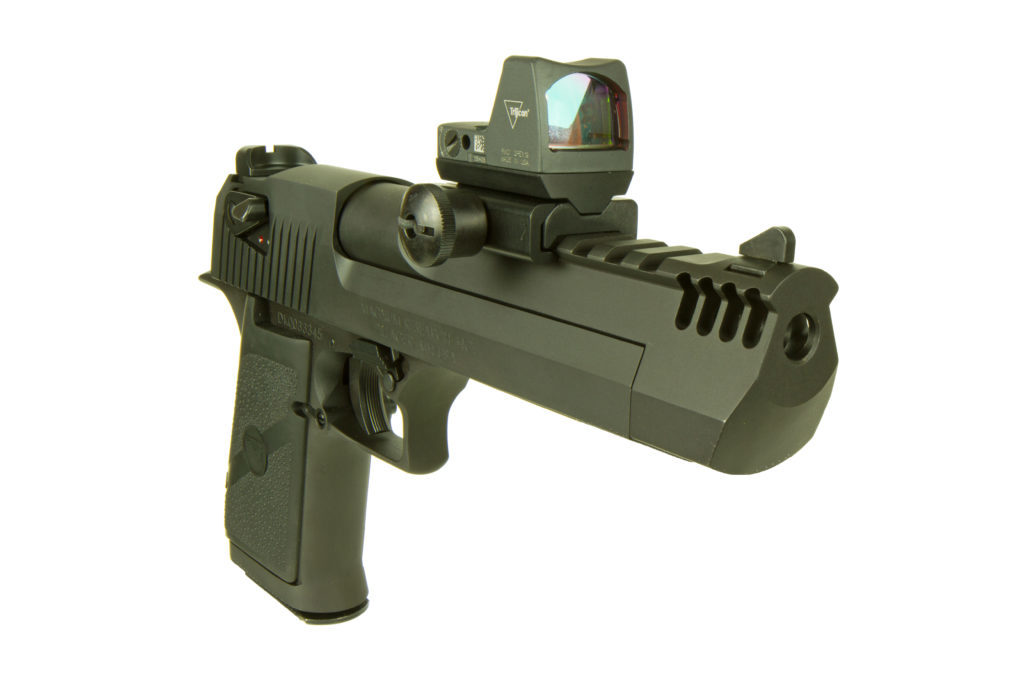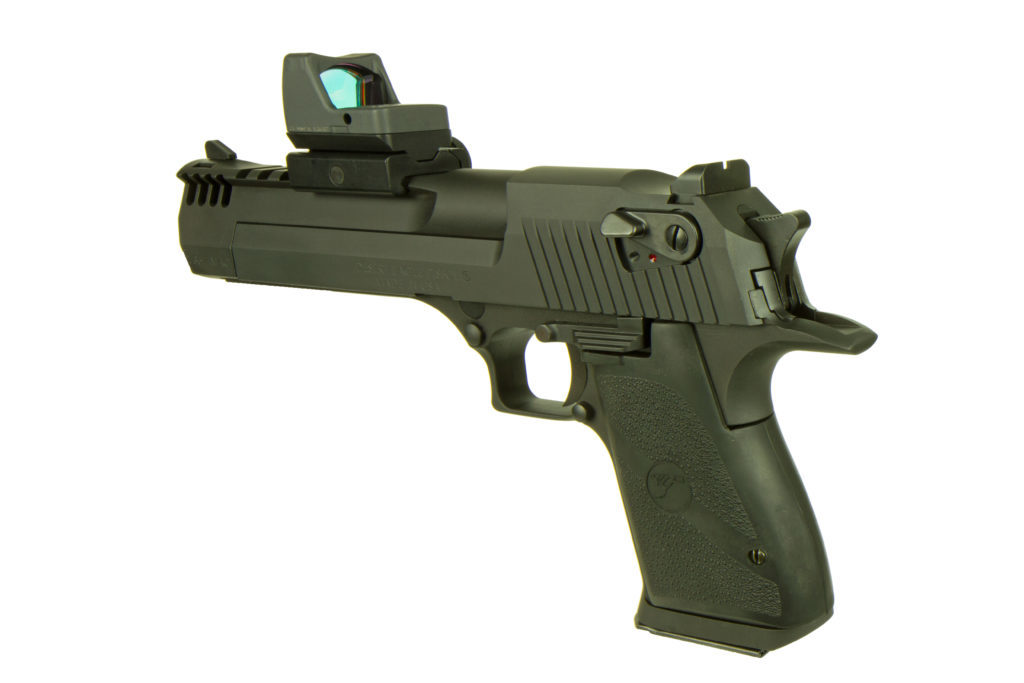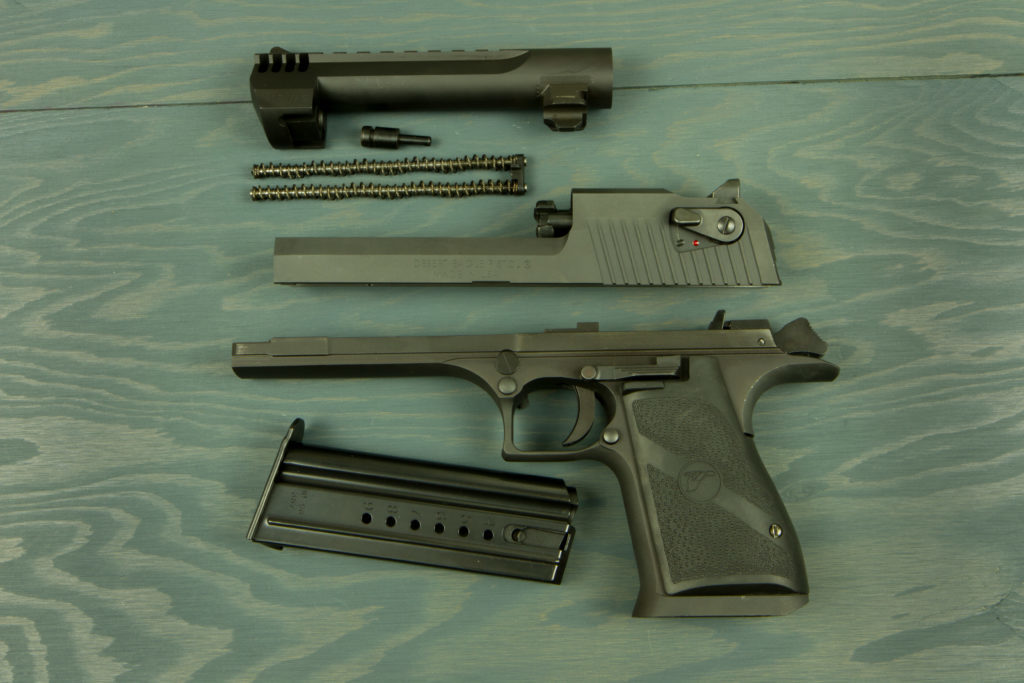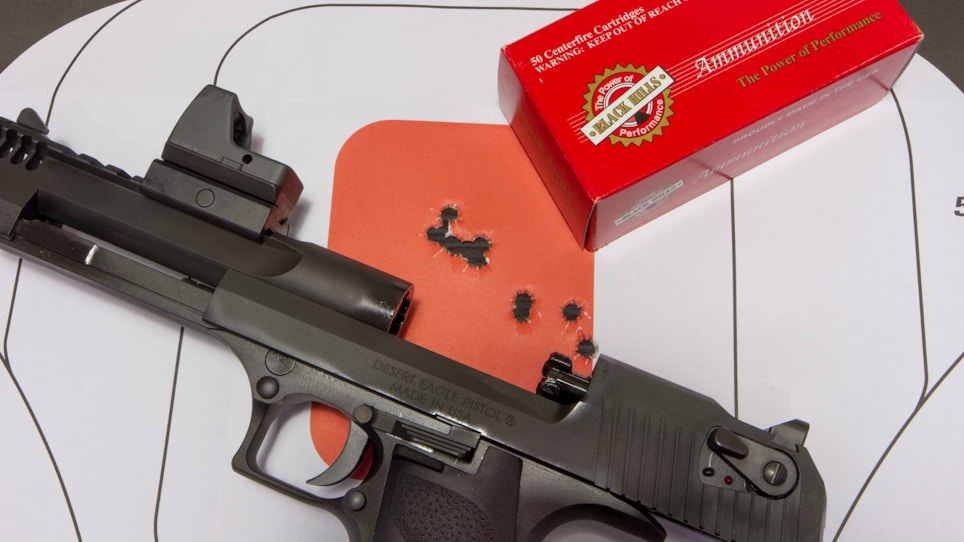It’s big, it’s heavy and it’s not for everyone. But many would be surprised at how useful the Magnum Research Desert Eagle Mark XIX in .357 Magnum can be. First, potential buyers need to set aside preconceived notions inspired by Hollywood fantasy and then learn about the features and benefits of the big gun. That’s where the smart retailer can not only help the customer, but also make that sale.
Frequently the big Desert Eagle is seen in movies and on television being deployed from concealment in depictions of armed combat, usually in an urban environment where it is wielded by a bad guy intent on mayhem. It is used in the entertainment industry because it is big and is visually appealing, despite it being impractical to use in the way shown by directors. Toting that gun concealed, whether chambered in .357 Magnum, .44 Magnum or .50 Action Express, just doesn’t work very well because of its size and weight.
But the .357 Magnum has long been recognized as an effective self-defense round. And although the gun is too large and heavy to be practical for discreet carry, in a home where it can be kept in a handy place, some may find it a good solution for defense. And since the .357 Magnum is powerful enough to be lawful for use as a hunting round in some states, it can also bring home the meat.

The Magnum Research Desert Eagle Mark XIX in .357 Magnum is a big gun with a lot of features. The gun's weight, integral muzzle brake and gas operating system do an excellent job of reducing felt recoil.
Recoil
The effects of recoil from firing a .44 Magnum or a .50 Action Express Desert Eagle, especially in the lightweight versions now available, are not pleasant for most shooters, but the felt recoil generated by the .357 Magnum gun with a steel frame and ported barrel is much less. It is even less than that generated by a .357 Magnum service revolver. There are several reasons why.
A Smith & Wesson model 686 chambered in .357 Magnum with a 6-inch barrel and seven-round cylinder registers about 45 ounces, while the Desert Eagle Mark XIX with steel frame and 6-inch barrel weighs in at about 73 ounces. That extra weight makes the gun less appealing to carry, but absorbs recoil and makes it much more controllable.
Then there is the operating system. Where a revolver has no reciprocating parts, like a slide or recoil springs, the Desert Eagle does. And some of the recoil energy is used to move these parts instead of being delivered directly to the shooter in one almost instantaneous jolt. And the felt recoil is further reduced by the Desert Eagle’s gas piston system.
A typical service caliber semi-automatic pistol uses a system where the barrel and slide are locked together initially during recoil until pressure drops enough that the slide and barrel can be separated safely allowing the empty shell to be ejected before the system feeds another round into the chamber. That is usually accomplished by a tilt barrel design that employs a mechanism similar to the original Browning link or a modified Browning tilt barrel design. While that system does lengthen the time in which recoil is delivered to the shooter’s hand, it still delivers a significant amount of felt recoil. But the Desert Eagle’s gas system further reduces the felt recoil.
Add barrel porting, which reduces muzzle flip, and the recoil impulse generated by the Desert Eagle is surprisingly soft. All of these characteristics make shooting the Desert Eagle much more pleasant and forgiving than one would expect. So, although the gun is generally too large and heavy to be practical for self-defense carry, it may be a viable solution for defense inside the home.
And the Desert Eagle can be a great hunting handgun where regulations allow. Some hunters enjoy not having to lug a rifle around while others relish the challenge of getting close enough to game for a humane kill with a handgun. So the big Desert Eagle has features and benefits for hunters that your customers may not recognize, but that they may find appealing.
Accuracy

The Desert Eagle Mark XIX has a large grip that might be difficult for shooters with small hands to hold, but it is a pleasant and accurate shooter for those who can get a good grip.
Because the barrel does not move significantly during the firing cycle compared to other semi-automatics using a tilt barrel design, there is less variation in the relationship of sights to barrel axis. This means the difference between point of aim (POA) and point of impact (POI) is more consistent and repeatable than with other semi-automatic designs. And if an optic like a long eye-relief scope or red-dot sight is attached, there is no change in POA and POI because the barrel and optic move in unison.
For testing, the very tough RMR from Trijicon was attached to the Weaver-style rail that is standard on the Mark XIX. The bore to sight line offset is increased, but once the gun is zeroed and tested at different ranges, it is easily dealt with. By using the RMR, any inaccuracy caused by inability to clearly focus on the front sight or center it in the rear notch is eliminated. The dot appears to be superimposed on the target, so corrective lenses or aging eyes are much less of a problem.
But for those shooters who prefer iron sights, yet want to be able to adjust them beyond what simple drifting in the dovetail can accomplish, Magnum Research offers a fully adjustable rear sight and fiber optic front sight. And if the owner wants a magnified optic, one can be installed. All of these options can enhance accuracy.
Testing
From a pistol rest at 25 yards using the RMR, the Desert Eagle averaged groups of a little over 1 inch to about 2½ inches. A word of caution, though, is the Desert Eagle can be sensitive to ammunition. So, the owner should carefully test any loads prior to using them for defense or hunting.
Further testing of the Desert Eagle using a two hand hold at silhouette targets placed 7 yards from the firing line showed the gun to be easy to aim. The recoil delivered to the shooter was more a gentle push than an abrupt impulse, and muzzle rise was minimal allowing for fast follow-up shots. In fact, because of the ported barrel and weight of the gun, it was more pleasant to shoot than some service size semi-automatics in lesser calibers.
Instructions
The owner’s manual says not to use unjacketed ammunition or full-
metal jacketed ammunition that has an exposed, unjacketed lead base. Lead bullets that are not jacketed will fail to engage the polygonal rifling and deposit lead in the barrel which could result in serious problems. Also, if the base of a jacketed bullet has exposed lead, hot gas from combustion picks up small particles of lead that will foul the gas port and cylinder. Magnum Research will gladly provide owners with information regarding commercial loads that work with the gun.

Disassembly is different but simple. The recoil spring has two guide rods to seat properly for assembly, and the gas piston must be oriented to work properly.
The owner’s manual contains much information that is important for shooters to know before operating the Desert Eagle. It contains all the normal warnings, but because the Desert Eagle is a bit different than most guns, it is important to read. For example, the slide mounted safety not only blocks the firing pin so it cannot move forward, but it also disconnects the trigger when engaged. And the six ribbed polygonal rifling with its 1:14-inch twist reduces barrel wear and creates a better seal between bullet and barrel than conventional rifling does.
Disassembly for cleaning and lubrication is also a bit different. A special tool — provided by Magnum Research — is used to remove the bolt guide pin and to ream out the gas cylinder. Reinstalling the rotating bolt with its three lugs that securely lock it to the barrel can be a bit tricky. When assembling the gun, it is important that the gas piston be installed correctly. Also both of the recoil spring guide rods — yes, there are two — must line up correctly with recesses in the frame.
Manipulation
Other interesting features of the Desert Eagle include a trigger that is easily adjustable for travel by simply turning a screw. The amount of take up can be increased or decreased, but the trigger weight cannot be changed. Unadjusted from the factory, the test gun’s trigger exhibited a bit of take-up, followed by ever so little creep then a clean break and a slight amount of overtravel. The trigger was easily manageable. Although the trigger group can be removed and the manual includes instructions to do so, it is not normally necessary and does require a hammer and punch.
The Desert Eagle is supplied with one nine-round magazine, but it is advisable to purchase several with the gun. Although the magazine proved reliable with the test gun, magazines are often a source of malfunctions with any semi-automatic and they do wear out. So it is best to get several magazines with the original purchase, just in case.
The magazine well is nicely beveled and flared to make changes fast, and the magazine release is positioned on the grip at the rear of the trigger guard so it is easy to activate. The grip is rubberized for good purchase, and a generous beavertail prevents hammer bite. The slide catch has a wide shelf to make engaging it easy, and is automatically engaged after the last round in a magazine if fired.
Cycling the slide by hand, despite the dual recoil springs, will probably not be difficult for most shooters because the serrations at the rear of the slide are generous and the size of the slide provides a good deal of room to grasp it. Manipulating the slide-mounted safety will probably require the use of the support hand though because of the size of the gun. Only people with unusually long and strong thumbs will likely be able to manipulate it with the shooting hand.
At first glance, the Magnum Research Desert Eagle in .357 Magnum may appear to be a specialty gun with limited uses that will appeal to a small segment of the shooting community looking for something unique. But if one considers the options and really looks at how versatile the gun is, it becomes apparent that the Desert Eagle has many practical uses.
For more information, contact Magnum Research at (508) 795-3919 or visit www.magnumresearch.com.






